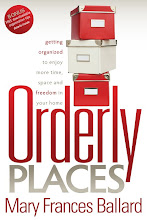This month is packed with lots of activities and last minute things to do. Having a good checklist will help keep you on track.
1. Mail out of town packages as soon as possible. There are some deadlines for overseas mailings.
2. Finish that Christmas newsletter and get those cards in the mail. Be sure you have kept a master list so changes in addresses, etc. can be made. Purchase "Forever" stamps rather than Christmas stamps. They can be used even when postage goes up.
3. You should have already sent out invitations to holiday activites you plan to host. If not, the sooner the better. As responses come in, update your list of the number you are serving.
4. Watch sales for last minute gifts, decorations, etc. that you need. Most online purchases will give free shipping but be sure they will be delivered in time. Be sure to keep all receipts in a special place for easy access if needed.
5. Make a grocery list of what you will need for your holiday events or feast. Purchase items when they are on sale. Keep the list, recipes and menu close at hand.
6. Begin decorating as soon as convenient. The best time is when you have help. Make the most of what you have. Basic wreaths that can have the bows changed with the seasons never need storage. Adding holiday bows or greenery to other permanent accessories such as candles can make them festive. Avoid purchasing items specific only to this holiday as they require storage space the remainder of the year.
7. Wrap packages as soon as you have them. If you decide to set aside a specific time, be sure you don't forget where they are hidden. Keep wrapping papers to a minimum. One or two plain colors and colorful bows are best. Children can decorate brown paper or white papers with colorful markers, stamps, etc. if you want them more festive.
8. Begin traditions with your family if you have not already begun them. For young children, simple activities such as baking cookies or decorating packages are best. Older children can help with community or church events. The family can purchase gifts for an "Angel Tree", read the Christmas story together, watch a favorite Christmas movie, etc.
9. Make a detailed schedule of what needs to be done before the big event. Work backwards in hourly increments on the big day and daily for a few days before.
10. Take pictures of family and friends and the decorations you chose as a keepsake and reminder for next year.
11. Be flexible on the big day and welcome any help offered. Don't sweat the small stuff and keep the mood light and festive.
12. Avoid the after Christmas sale unless you absolutely need the items. Avoid the long lines, parking problems and traffic jams. Items that need to be returned can usually wait for a few days.
13. Keep a journal of what worked and what didn't, the gifts you gave and any changes you would make in the future. Keep a list of clutter free gifts you can give next year. Keep a folder on paper or the computer of all the lists, ideas, recipes, pictures, evaluations,etc. related to the holiday.
14. As you take down the decorations, consider purging what you can. Eliminate as much permanent storage as possible. Try to maintain only those things with special significance or cannot be replaced.
15. Set a family goal to make the holidays even more meaningful next year. Adopt a charity, volunteer in the community, participate in your church holiday program, etc. Write down your decision and make plans for it next year.

